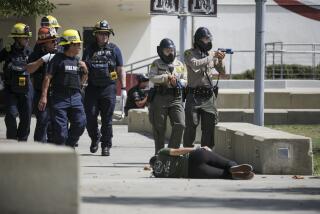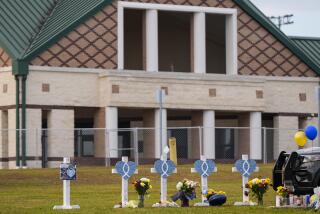Turn Warnings Into Prevention
There is no magic policy wand that schools can wave to absolutely prevent what happened Monday--a 15-year-old boy accused of spraying gunfire in a suburban San Diego high school, killing two people and wounding 13. However, Charles Andy Williams’ reported behavior did fit many of the textbook criteria for a likely school shooter, as outlined in an FBI report prepared after 1999’s deadly shooting spree at Colorado’s Columbine High School. Williams issued plenty of warnings, apparently telling about 20 people, including at least one adult, over the weekend of his plans; he reportedly had access to guns; and he had a history of being taunted by fellow students. “He always gets picked on. He’s scrawny, he’s little,” fellow students said. “He was often the butt of jokes at school.”
Since Columbine, Gov. Gray Davis has worked to help California schools develop safety measures recommended in the FBI report, allocating $101 million to help school districts increase counseling staff. Still, California continues to rank last among all states, with a student-to-counselor ratio of 979 to 1.
California’s poor student-to-counselor ratio is particularly troubling in light of a study issued by the state Department of Education last week showing that the rate of violent offenses in schools, including battery and sexual assault, increased by a sharp 17% last year.
The federal Education Department’s Crisis Intervention Training program is a model of how to help teachers follow their hunches about a student they suspect is in danger or is a danger to others. The program helps teachers and school officials gauge whether they are facing a credible threat and the potential of it being carried out. Assessments can include interviewing the student and parents, monitoring the student’s activities, seeking outside mental health help or, in extreme cases, contacting police. Without an assessment plan in place, it’s too easy for teachers and other district employees to second-guess their own concerns and not warn anyone.
For students, the Think First curriculum, pioneered by psychology professor James Larsen at the University of Wisconsin, offers widely acclaimed group sessions that help teenagers focus on self control, social competence, positive peer relationships and interpersonal problem solving.
At the national level, Sen. John McCain (R-Ariz.) should make good on his recent promise to introduce, with former Democratic vice presidential candidate Joseph I. Lieberman, gun control legislation that requires a waiting period at gun shows, mandates trigger locks on guns and increases funding to enforce existing gun laws.
Nothing, of course, assures that tragedy can be prevented, but leaders from the classroom to the White House can clearly take more steps to promote school safety.
More to Read
Sign up for Essential California
The most important California stories and recommendations in your inbox every morning.
You may occasionally receive promotional content from the Los Angeles Times.










